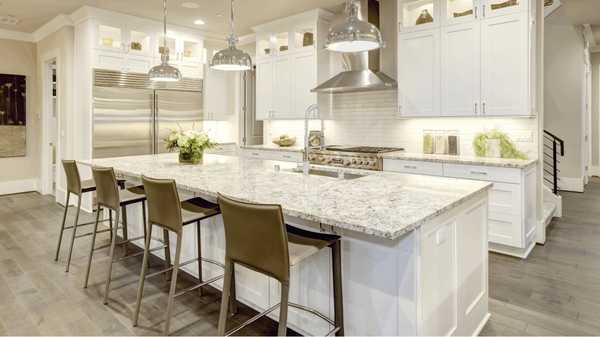5 Essential Fall Home Maintenance Tips for Dayton Homeowners

🍂 Why Fall Maintenance Matters As the leaves start to change in Dayton, homeowners know that the season isn’t just about pumpkin patches and cozy nights, it’s also the best time to get your home ready for colder months. Taking care of a few key tasks now can save you from bigger (and more expensiv
Read MoreTransform Your Kitchen into a Luxury Chef's Paradise: 2025's Most Coveted Features

Walking into a luxury kitchen feels different. There's something about the seamless blend of beauty and function that makes you want to create culinary masterpieces – or at least look good trying. But what exactly creates that luxury feel? Let's explore how to transform your kitchen into the sophist
Read MoreTransform Your Home with Luxurious Outdoor Living Enhancements

In today’s world, our homes are more than just places to live; they are reflections of our lifestyle and personality. One of the most exciting trends in home design is the focus on outdoor living spaces. Imagine stepping outside to a beautiful area that feels just as luxurious and inviting as your
Read MoreHow to Create a Calm and Organized Home in the Post-Holiday Chaos

As the last gift wrap is tossed, the holiday decorations packed away, and the excitement of the season begins to settle, January often greets us with a home that feels anything but serene. The festive chaos leaves behind a trail of clutter, misplaced items, and perhaps a little post-holiday fatigue.
Read MoreSpark Joy in Your Home: Marie Kondo's Decluttering Guide

As the year draws to a close, many of us find ourselves reflecting in the past months and looking forward to a fresh start. What better way to begin the new year than with a serene, clutter-free home? Let's explore the art of decluttering, inspired by the renowned Marie Kondo, and discover how it c
Read MoreWindow Innovations: Blending Form and Function for 2025

"I never knew what light was until it poured through a well-designed window." - Frank Lloyd Wright once mused, and honestly, who hasn't had a moment staring out their window wondering if it could do... more? Gone are the days when windows were just holes in walls with glass stuck in them. (Sorry, m
Read MoreMaximize Your Space with Built-In Storage Solutions for a Clutter-Free Home

If you’re feeling overwhelmed by clutter in your home, you’re not alone. Many homeowners struggle with finding enough space to store their belongings while keeping their living areas tidy and functional. Built-in storage solutions can be the answer to your organization woes, providing stylish and e
Read MoreEssential Tips On How to Prepare Your Home for Winter

As the leaves change and temperatures drop, it’s time to prepare your home for the winter months ahead. Proper seasonal maintenance not only ensures your home remains cozy and safe but can also save you money on energy bills and prevent costly repairs down the line. Here are essential tips to help y
Read More10 Smart Home Updates That Actually Save You Money

In today's tech-savvy world, smart home upgrades are more than just cool gadgets – they're powerful tools for saving money and increasing your home's efficiency.These intelligent solutions are becoming more accessible and cost-effective than ever before. Let's explore ten smart home updates that not
Read More8 Budget-Friendly Ideas for a Luxurious Bathroom

Have you ever walked into your bathroom and felt like it was stuck in a time warp? Maybe the outdated tiles, the faded wallpaper, or the worn-out fixtures make you cringe every time you step inside. We've all been there, and it's easy to feel overwhelmed by the idea of a complete bathroom renovatio
Read MoreOptimize Your Home Office: Design, Routine, and Productivity Tips

In today’s world, working from home has transitioned from a temporary arrangement to a daily routine for many. This shift has blurred the boundaries between home life and work life, making a dedicated office space more important than ever. Whether you're managing household tasks, sorting through pa
Read MoreHow to Choose the Best Flooring for Every Room

Finding the perfect flooring for your home goes beyond just picking something that looks nice. You need to consider factors like moisture, durability, and cost, as well as the specific needs of each room. Because of this, you might end up choosing different flooring types for different spaces. Expl
Read MoreTransform Your Kitchen: 12 Essential Tips for Organization and Functionality

We all want our kitchens to look nice, but what good is a beautiful kitchen if it’s not practical? A functional kitchen makes cooking and cleaning much easier. Kitchens are more than just places to cook. We gather with friends, have family talks, and spend time there. Making your kitchen organized
Read MoreTransform Your Space: Create a Reading Nook Your Family Loves

It's a book lover's dream to have a home library, but sometimes there's just not enough space. Luckily, even in small areas, you can create a cozy reading nook without giving up too much room. Wondering where to keep all your books? Finding the right bookshelves is key. Creating a comfy reading noo
Read More11 Simple Tricks to Freshen Up Your Home's Scent

Ever walked into a friend's house and instantly felt at home because of its comforting scent? Or maybe you've crinkled your nose at an unpleasant odor lurking in your own space. It's true, every home has its own unique aroma. But how do you make sure yours smells inviting rather than off-putting? T
Read MoreTransform Your Yard for an Enjoyable Outdoor Experience

After spending months cooped up indoors, you'll be ready for a different view! Why not bring the excitement closer to home by maximizing your outdoor space? Whether you have a spacious backyard ideal for social gatherings or just a small stoop or balcony, there are ways to transform your outdoor
Read MoreHome Transformation: 6 Renovation Tips Homeowners Need To Know

Feeling excited to start renovating your home but not sure where to start? You're not alone. Lots of homeowners jump into renovations without a clear plan and run into problems. Renovating a house is tricky and can be overwhelming if you're not ready for it. Don't worry! By approaching things the r
Read MoreHome Maintenance Tip: Keep Your Landscaping in Shape

As the summer heat takes hold, it's essential to prioritize outdoor home maintenance to ensure your property looks its best and remains a comfortable oasis during the warmest months. One crucial task for homeowners in July is to focus on the landscaping. Regularly maintaining your garden and outdoor
Read MoreGet Ready to Refresh and Renew with These Spring Cleaning Hacks!

Spring is the season of renewal and rejuvenation, and what better way to embrace this spirit than with a thorough spring cleaning? It's time to put away the winter blues and welcome the new season with a clean, organized, and refreshing home. However, the idea of deep cleaning your home from top to
Read MoreDIY Home Decor on a Budget: Transform Your Space Without Breaking the Bank!

As we spend more and more time at home, it's natural to want to create a space that feels both beautiful and comfortable. However, the cost of home decor can add up quickly, leaving many of us feeling frustrated and overwhelmed. Luckily, there are plenty of budget-friendly DIY home decor ideas that
Read More
Categories
Recent Posts










